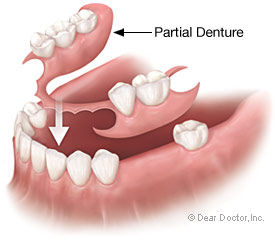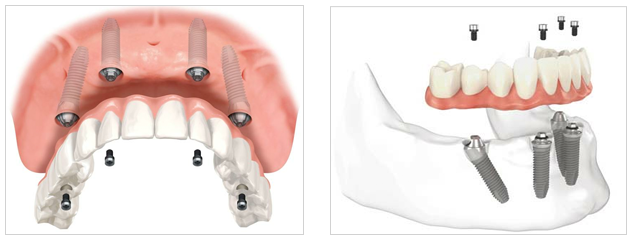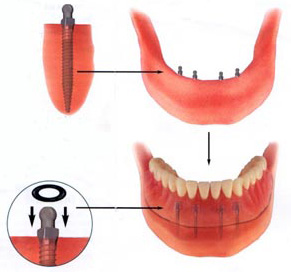Dentures
We are able to offer full or partial dentures to patients wanting find a solution for missing teeth. Our dentures are designed to be a lightweight, comfortable and aesthetically pleasing restorative solution.
If you have lost some or all of your natural teeth, dentures can be used to replace your missing teeth, improving your oral health as well as your facial appearance. Dentures (both full and partial) prevent the sagging and dropping of facial muscles and tissues which makes a person with no teeth look much older and more wrinkles.
Dentures are removable replacements for missing teeth, artificial teeth made out of an acrylic resin, which incorporate porcelain or metal for additional structural support.
People lose teeth for many reasons including accident, tooth decay and gum disease. Dentists offer more than one options for replacing the missing teeth. Dentists help patients base their choice on comfort and cost. For cost and convenience, the disadvantage of partial dentures is that they feel foreign and unnatural. Most people adapt well to a removable partial denture; some people do not.
Time is a consideration when replacing missing teeth. Although it may be possible to replace teeth with dental implants in a very short time, usually it takes months, even over a year. Partial denture treatment is normally complete in days to a few weeks.

The most common partial denture includes a cast metal framework, metal clasps that are carefully designed for individual teeth and pink acrylic, teeth is either factory manufactured acrylic or porcelain teeth.
Alternative to standard metal clasps are clasps made of a tooth or gum colour plastic. Patients appreciate the smooth feel of the plastic clasp as it slides over the tooth when compared with the scraping feel of a tight metal clasp. These clasps appear to last nearly as long as those made of metal. The major disadvantage of plastic clasps is that they must be larger than those made of metal.
Another kind of partial denture is made of a flexible nylon material called Valplast or Flexite. Some patients appreciate the feel of partial dentures made of a resilient material. Flexible partial dentures move around with respect to the other teeth more than conventional partials. These partials depend more on the soft tissue for support.
Flexible partial dentures are difficult or impossible to repair. Acrylic partials are relatively easy to repair. When another natural tooth is lost, it is likely that the dental lab technician is able to add a replacement on to an acrylic interim or conventional acrylic and metal partial.
There are important considerations when leaving the dental surgery, with a new partial denture. For a while the partial will feel funny. This is a sizable object. Its presence may cause increasing salivation during the adjustment period.

Learn to speak with the new partial by practicing. Try reading the newspaper out loud to a large mirror. Eat soft foods at first. Noodles, soup, tofu, and bananas are good foods to begin with. Later, add small pieces of firm, chewy and crunchy foods. Do not expect to eat large bites of sandwiches and steak with partial dentures. Never use the plastic front teeth of dentures to tear or bite into foods, instead, tear off pieces of a sandwich or pizza and chew it will back or side teeth.
With a Careful design and systematic care of partial dentures will support and extend the life of associated natural teeth. That care must include impeccable hygiene (brushing and flossing), regular professional care, and adjustment of the partial as the teeth and gums change over time. Leave partials soaking in a container of water at night; dry acrylic may warp or crack.
To maintain the dentures and the oral health, you have to brush your gums, tongue, and palate every morning with a soft-bristled brush before you insert your dentures to stimulate circulation in your tissues and to help remove plaque on the remaining teeth.
Please, ask the dentist to help determine which kind of partial denture is the best for you.
Implant Supported Denture
An implant-supported denture is a type of over denture that is supported by and attached to implants. A regular denture rests on the gums, and is not supported by implants.
An implant-supported denture is used when a person doesn’t have any teeth in the jaw, but has enough bone in the jaw to support implants. An implant-supported denture has special attachments that snap onto attachments on the implants.
Implant-supported dentures usually are made for the lower jaw because regular dentures tend to be less stable there. Usually, a regular denture made to fit an upper jaw is quite stable on its own and doesn’t need the extra support offered by implants. However, you can receive an implant-supported denture in either the upper or lower jaw.
You should remove an implant-supported denture daily to clean the denture and gum area. Just as with regular dentures, you should not sleep with the implant-supported dentures at night. Some people prefer to have fixed (permanent) crown and bridgework in their mouths that can’t be removed. Your dentist will consider your particular needs and preferences when suggesting fixed or removable options.
Implant-supported dentures: bar-retained and ball-retained. In both cases, the denture will be made of an acrylic base that will look like gums. Porcelain or acrylic teeth that look like natural teeth are attached to the base. Both types of dentures need at least two implants for support.

- Bar-retained dentures — a thin metal bar that follows the curve of your jaw is attached to two to five implants that have been placed in your jawbone. Clips or other types of attachments are fitted to the bar, the denture or both. The denture fits over the bar and is securely clipped into place by the attachments.
- Ball-retained dentures (stud-attachment dentures) — each implant in the jawbone holds a metal attachment that fits into another attachment on the denture. In most cases, the attachments on the implants are ball-shaped (“male” attachments), and they fit into sockets (“female” attachments) on the denture. In some cases, the denture holds the male attachments and the implants hold the female ones. the following is the other type of ball retained dentures.(Mini Implant)
Mini Implant
How are the MDI Mini Implants placed?
Placement of the implant is accomplished quickly and easily in a process performed in the dentist’s office, with local anaesthesia. Using a precise, controlled and minimally invasive surgical technique MDI implants are placed in the jawbone. The heads of the implants protrude from the gum tissue and provide a strong, solid foundation for securing your artificial crown 2 weeks later. Because of the minimally invasive nature of this procedure, MDI placement doesn’t require a lengthy healing period, meaning impression for crown can be taken the same day the mini implants are placed, and your crown can be issued 2 weeks later.









